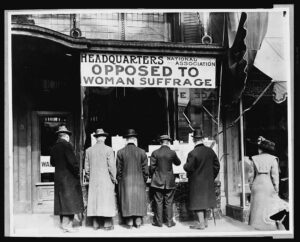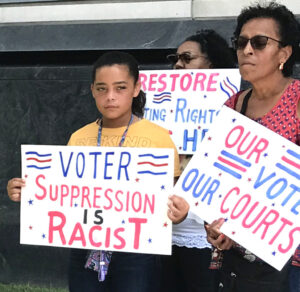A guest blog by Helen Gibbins, League of Women Voters Huntington Area

A yellow ribbon from a 1911 suffrage parade. Image source: Library of Congress
“VOTES FOR WOMEN” was a rallying cry in the 19th and early 20th centuries. Women finally achieved that right when the 19th Amendment to the Constitution was finalized on August 26, 1920.

Men looking at materials presented by the National Association Opposed to Woman Suffrage. Image source: Library of Congress.
It was not an easy path to the ratification of the 19th Amendment. Suffragists were usually opposed by their husbands, families, and communities. Several generations of suffragists spent years meeting, appealing, protesting, writing, lobbying, marching, and crusading before the White House. Some were thrown into jail where they were abused and tortured. Finally, Congress was convinced that eligible voters should also include women. In August, 1920 the 19th Amendment was finally affirmed by the required 36 states.
However, the implementation of the 19th Amendment was not assured in the South. In 1870, the 15th Amendment gave the right to vote to African American men; but after Reconstruction, many black men were blocked from voting by requiring senseless literacy tests and poll taxes. Intimidation included threatening the loss of jobs and homes and even, in some case, their lives.Those practices extended to African American women after the 19th Amendment was passed. Likewise, some states blocked Native Americans from voting.
The Civil Rights protests and the 1963 March on Washington brought the vicious and onerous practices against minorities to the attention of the public. It took the Voting Rights Act of 1965 to correct those travesties.
But in 2013 along came the Supreme Court ruling, Shelby County v. Holder. It negated many of the protections of the Voting Rights Act. Following this court decision, more than 16 states passed bills that made it more difficult for African Americans and other communities of color to access the ballot box.
Fast forward to 2019. The House of Representatives passed HR 1, “For the People Act” to remedy the obstacles to voting passed by a number of states. and to find alternative ways to protect the Voting Rights Act from its stripped provisions. HR 1 will make voting easier and more accessible by modernizing our elections and putting power back in the hands of the American voters. HR 1 is languishing in the Senate.
While we celebrate the passage of the 19th Amendment, we must also work continually to protect the Right to Vote; one good way to do that would be for the Senate to pass HR 1.
And, we must participate in Voter Registration and Get Out the Vote campaigns.
So many of our forbears have worked hard and even suffered to attain the right to vote for all of our people. Let’s remind our friends that Democracy is not a Spectator Sport.











